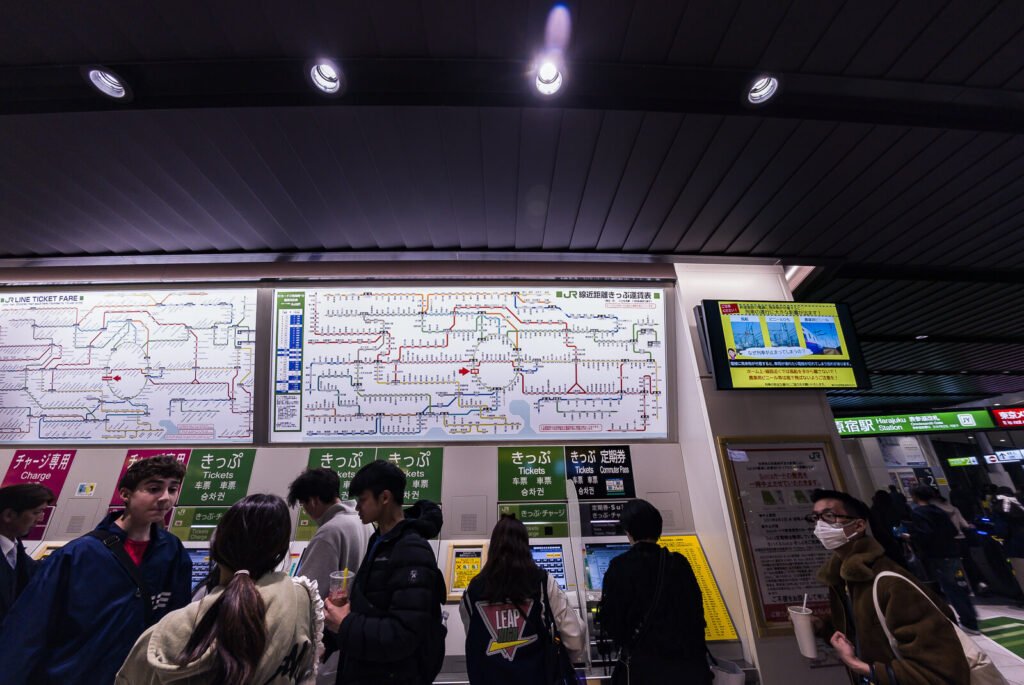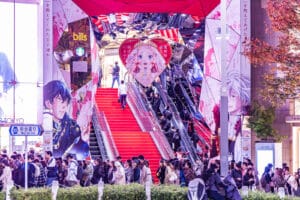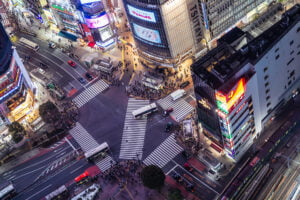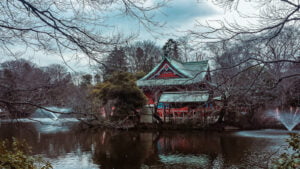Before we dive in, quick heads up. If you find my tips helpful—and click any of the links—it actually helps support this blog. Don’t worry, costs you nothing. Yup, zero extra. But it keeps my travel stories alive. Honestly, it’s kinda cool knowing you’re helping me keep these adventures coming. So, thanks. Really.
Introduction to Harajuku
Harajuku didn’t welcome me. It ambushed me. Neon wigs, platform boots, someone dressed like a cupcake—no warning, just boom.
This isn’t Tokyo polished. This is Tokyo unfiltered. Loud, weird, glorious. A teenager in a kimono sips bubble tea next to a punk with safety pins in his cheeks. Neither blinks. No one cares. That’s the magic.
Takeshita Street? It’s not just vibrant—it’s claustrophobic in the best way. Cotton candy bigger than your head. Stickers. Screams. Perfume clouds. You move with the crowd or you get swallowed.
Then, suddenly—quiet. You drift into Meiji Shrine’s shadow. Gravel crunches. Crows cry. And it feels like the city held its breath for a second just for you.
Fashion malls here don’t just sell clothes. They sell moods. Identities. Some aisles feel like sci-fi. Others like fever dreams. You try stuff on you’d never admit to liking. And somehow, it fits.
Harajuku isn’t a place. It’s a challenge.

Historical background of Harajuku Japan
This article includes affiliate links that do not incur additional charges for you. I may receive a modest commission if you click on them and make a purchase.

Wanna go to Japan? Find affordable flights here.
The area was originally a small village inhabited by low-level samurai. It was only after World War II that Harajuku became the center of fashion and youth culture. Washington Heights, the US Army Barracks were built here.
Since there were a lot of American military families living there, shops opened to cater them. This led to curiosity among youth living around Harajuku about western culture. In the 1950s, Omotesando Central Apartments were constructed for the American military. Since there were a lot of offices available in the building , many creative Japanese people stayed there.
In 1964, during the Tokyo Olympics, the athletes were housed in Washington Heights. It led to the opening of boutiques and cafes. In 1964, Mademoiselle Non Non opened, which was Japan’s first boutique. In 1978, the Laforet fashion mall was opened. It contributed to Harajuku becoming the center of youth fashion and creativity.
Must-visit spots in Harajuku
Takeshita Street: The bustling hub of fashion and trends


One of the most popular streets to walk on for younger people. You can access Takeshita street from Harajuku station’s East entrance. There was a very cute old station but now it’s a brand new station.
You can see a lot of tourists taking pictures in front of the sign at the entrance of Takeshita Dori. If you come on the weekends or a public holiday, then it will be very crowded. So try to come on a weekday.
The moment you enter Takeshita Street, there is a small street on the right side where you can buy some souvenirs. It leads to a small courtyard where you can find some Gachapon machines and claw machines.
Omotesando

Omotesando is home to high end luxury brands and a lot of boutiques. Some of the big brands are Miu Miu, Prada, Balenciaga, Burberry, Louis Vuitton, Fendi, Dior, Apple, Chanel, Zara, etc.
If you are looking to buy high quality chop sticks, then there is a shop called Ginza Natsuno. Oriental Bazaar is a Japanese souvenir shop. It’s located near the Chanel store on a side street.
Kiddy Land is a famous shop for a variety of cute toys. It’s famous for it’s huge collection of character merchandise. It offers a wide variety of products featuring popular Japanese characters, anime franchises and international brands.Some of the top brands are Hello Kitty, Pokemon, Disney, Studio Ghibli and many more.
Meiji Shrine: A tranquil escape in the midst of chaos

It is one of the most famous shrines in Japan, located very near the train station. Meiji Jingu is a shrine dedicated to Emperor Meiji and his wife. From the gate, it is around a 15 minute walk to the main shrine. It’s a perfect getaway from the hustle and bustle of Harajuku. The walk towards the main shrine under the shady trees is very peaceful and relaxing. The area has a museum and a garden but these have to be paid for. The visit to the shrine is free.
Meiji Shrine: Journeying Through Tokyos Meiji Shrine
Yoyogi Park: A green oasis for relaxation and people-watching

Wanna go to Tokyo? Find affordable tours here.
Yoyogi is a popular park known for its rich history and cultural significance. This location is a renowned rendezvous point for Japanese couples, situated merely a 5-minute stroll from Harajuku Station. Additionally, it’s highly favored by YouTubers as a prime spot for conducting interviews for their YouTube channels. Historically, it is famous for Japan’s first powered aircraft flight in 1910 by Captain Yoshitoshi Tokugawa. It served as Olympic village during the 1964 Olympics, and before that, it was used for US military housing. In spring, it’s a nice hanami spot and during autumn, the park becomes golden due to a lot of Ginkgo trees there.
Shopping in Harajuku



Right in front of the East entrance of Harajuku, there used to be a Gap store, now it’s Cosmic Tokyo, which sells cosmetics. There are Ikea and Uniqlo just beside this building. This is a small Ikea store . You can find similar Ikea stores in Shibuya and Shinjuku. It’s a new Ikea store. It has two floors. You can find a cafe on the first floor. You can get light meals like sandwiches and doughnuts and plant-based soft cream on the first floor.
Then there is Beauty Square, a cosmetic store. Tokyo Plaza is a multi-story department store. It’s famous for its iconic entrance of mirrored Kaleidoscope. It’s designed by Hiroshi Nakamura. Ascending or descending the stairs is a visually stunning experience for visitors. It is one of the best places for taking photographs.
My favorite place in this building is the Starbucks rooftop garden, known as Omohara Forest. It’s located on the 6th floor of the Tokyo plaza. It’s open from 8 am to 10 pm. You can relax after shopping and enjoy the beautiful view of Harajuku.
There is a big Daiso on Takeshita Street, right near the entrance. If you are looking for 100 yen stuff, then this is the best place. It is open from 9:30 am to 11 pm.
Experiencing Harajuku’s food scene



There is a McDonalds at the entrance of the street. They have the menu from the McCafe menu line so you can get things like Macarons.
Harajuku is also famous for crepes. There is a famous shop for crepes called Sweet Box in front of Daiso. There are tons of variations of crepes here.
When we go a bit down the street, there is Big Mama on the left side, where you can get Kebabs. Then there is a shop where you can get the longest tornado potato stick.
There is also a cotton candy shop called Strawberry Fetish to satisfy your sweet tooth. A few more crepe shops are Marion and Santa Monica.
Taiwan No. 1 Xing Fu Tang is a tapioca shop where you can enjoy various tapioca drinks and also look at the machine which spits out fresh tapioca.
Candy A Go Go is a famous candy shop down the street. For health conscious people, there is a shop called QBT where you can get broccoli and chicken with mayo sauce. You can find Lotteria at the end of Takeshita street.
Access

| Station Name | Train Lines | Distance from Harajuku Station | Fare from Shinjuku/Shibuya |
|---|---|---|---|
| Harajuku Station | JR Yamanote Line | – | 150 yen |
| Meijijingu-mae Station | Tokyo Metro Chiyoda Line, Tokyo Metro Fukutoshin Line | Short walk from Harajuku Station | – |
| Omotesando Station | Tokyo Metro Chiyoda Line, Tokyo Metro Ginza Line, Tokyo Metro Hanzomon Line | At the eastern end of Omotesando | – |
FAqs
What is Harajuku best known for?
Harajuku is famous for it’s street fashion. Fan’s of street fashion gather there to express there unique fashion ideas.
Do people still dress up in Harajuku?
Yes people still dress up in Harajuku. It’s scene is evolving with new trends.
Where to shop in Harajuku?
Drug Honey: You can shop for gothic and punk fashion at this store in Harajuku.
Address: 〒150-0001 Tokyo, Shibuya City, 16, 神宮前1-16-1 原宿関口ビル2F
Phone: 03-5770-8240
To Alice :
Address: 〒150-0001 Tokyo, Shibuya City, Jingumae, 1 Chome−6−12 2F
Hours: Open ⋅ Closes 8 PM
Phone: 03-6455-5479
Laforet: It’s a famous department store for youth fashion in Harajuku.
Address: 1 Chome-11-6 Jingumae, Shibuya City, Tokyo 150-0001
Hours: Open ⋅ Closes 8 PM
Phone: 03-3475-0411
G2? :
Address: 〒150-0001 3-22-7 Jingumae bldg,.2F, Jingumae, Shibuyaku
Hours: 11:00-20:00
Phone: 03-5786-4188
Where is Takeshita street?
Takeshita street starts across the road from old Harajuku station.
Where is Harajuku located in Japan?
Harajuku is the name given to a geographic area around Harajuku Station and Omotesando. It encompasses many famous streets, like Takeshita street and Cat Street,
Is it worth visiting Harajuku?
Harajuku is worth visiting for it’s high end boutiques and for kawai culture.
What is the most popular street in Harajuku?
Takeshita Street
Is Shibuya and Harajuku the same?
No, Shibuya and Harajuku are not the same. They are both different and very popular areas of Tokyo. Shibuya is a young and trendy shopping district known for its famous “Shibuya Scramble Crossing” and shopping malls.
Harajuku, on the other hand, is the center of Japanese youth culture and fashion, with “kawaii” fashion items and trendy shops. Harajuku also has “Takeshita Street”, famous for colorful shops and crepe stands. Both areas are known for their own characteristics and are very attractive places to visit in Tokyo.
What is the difference between kawaii and Harajuku style?
The main difference between Kawaii and Harajuku style is in their origin and manner of expression. Kawaii style, which means “cute” or “adorable,” is a broad concept in Japanese culture that incorporates cute and childlike elements in fashion, behavior, and accessories. It often uses soft colors, simple designs, and childish figures.
On the other hand, Harajuku style originated from the Harajuku area of Tokyo and is more diverse and experimental. Harajuku fashion includes various subcultures, such as Gothic Lolita, Decora, and Visual K. This style often uses bold colors, unusual silhouettes, and exaggerated accessories.
Why do people dress Harajuku?
People dress in Harajuku style because it gives them the freedom to express their personal style and creativity. Harajuku fashion began in the 1980s in the Harajuku district of Tokyo, and it emerged as a movement that was against society’s rigid rules and the pressure to fit into normality. he style is a mix of various Japanese subcultures, such as Sweet Lolita, Gothic Lolita, Visual K, Cosplay, Decora, Gyaru, and Punk Rock.
What kind of fashions do you often see in Harajuku?
Lolita: The Lolita style is inspired by Victorian-era fashion and usually includes knee-length cupcake-shaped skirts, petticoats, and knee-high socks.
Kawaii: The Kawaii style has ‘cute’ or ‘adorable’ elements and often uses light colors and simple designs.
Decora: The Decora style uses a lot of decorative accessories and bright colors.
Visual K: The Visual K style is associated with Japanese punk rock or metal bands and often features bold makeup and exaggerated hairstyles.
Fairy K: The Fairy K style features magical and fairy-like elements.
Gyaru: The gyaru style features an exaggeration of the American teenager image, with bleached or dyed hair, dramatic makeup, and very long nails.
Punk Rock: The punk rock style features rebellious and bold fashion elements
Can you cosplay in Harajuku?
Yes, you can cosplay in Harajuku. Harajuku is a neighborhood within Tokyo’s Shibuya ward that is famous for its Takeshita-dori shopping street, where fans of Japanese teenage pop culture show off their quirky fashion. Especially on weekends, many young people parade around Harajuku wearing anime-inspired clothing. Harajuku Bridge, which is Tokyo’s main cosplay area, is where you’ll find lots of people cosplaying.
In addition, in Harajuku you’ll also find shops to buy cosplay outfits. The fashion stores here sell Lolita fashion as well as cosplay outfits, school uniforms, and more. Harajuku places a high value on fashion and personal expression, and people can show off their creativity by dressing up in different styles to suit their preferences.
Who made Harajuku lovers?
The Harajuku Lovers brand was founded by American pop star Gwen Stefani. The brand is inspired by her fascination with Japanese fashion and the Harajuku district of Tokyo. Gwen Stefani launched the brand around the time of her solo album “Love. Angel. Music. Baby,” and introduced the concept of Harajuku Girls to the American market. The brand includes products such as clothing, toys, and perfumes inspired by Harajuku fashion and ‘kawaii’ culture.
More from Airashi Japan
Navigating Tokyo Transportation efficiently
Tokyo Shibuya Crossing: The World’s Busiest Intersection
Japanese Temples: Senso-ji and Nakamise Shopping Street
Exploring Tokyo: Unveiling Top Attractions and Hidden Gems
Kichijoji: Unveiling the Charm of Tokyo’s Hidden Gem
Yanaka: Old-World Charm and Quaint Streets
The Mystical Allure of the Torii Gate: A Gateway to Japanese Culture
Meiji Shrine: Journeying Through Tokyos Meiji Shrine
Exploring the Heart of Tokyo: Shinjuku
Tokyo Tower: Panoramic City Views
Omoide Yokocho: Tokyo’s Nostalgic Alley of Memories
Akihabara Electric Town : Tech and Anime Haven
Roppongi Tokyo: Fusion Hub of Culture and Nightlife






Pingback: Navigating Tokyo Transportation efficiently - airashijapan.com
Pingback: Best Places to See Autumn Foliage in Tokyo - airashijapan.com
Pingback: Recommended Reading for Your Journey to Japan - airashijapan.com
Pingback: Best Japan Travel Apps - airashijapan.com
Pingback: Spring in Tokyo: Sakura Dreams at Shinjuku Gyoen - airashijapan.com
Pingback: Harajuku St: Where Tokyo Street Photography Comes Alive - airashijapan.com
Pingback: Akihabara Electric Town : Tech and Anime Haven - airashijapan.com
Pingback: Yanaka: Old-World Charm and Quaint Streets - airashijapan.com
Pingback: The Mystical Allure of the Torii Gate: A Gateway to Japanese Culture - airashijapan.com